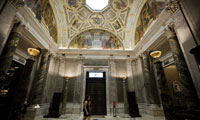 At the Morgan, Gently Restoring a Treasure-Filled Building
At the Morgan, Gently Restoring a Treasure-Filled Building When the Morgan Library & Museum reopened four years ago after undergoing a widely praised $106 million renovation and expansion, it seemed as if its problems had ended. Renzo Piano’s design, with its gleaming steel-and-glass entrance on Madison Avenue, soaring atrium, new gallery spaces and 280-seat auditorium, provided much needed space. It also gracefully linked the Morgan’s three disparate buildings and erased its awkward 1991 glass atrium.
But while the Piano design did much to update the institution’s fusty image and enabled curators to present several temporary exhibitions at once, it still did not provide nearly enough room to show off the Morgan’s permanent collection. And as beautiful as naturally lighted spaces are, they do not work for showing delicate works on paper, a problem for an institution with a wealth of drawings by Leonardo, Rubens, Degas and Schiele, among others.
Now William Griswold, the new director, is embarking on a $4.5 million project that will gently restore one portion of the old Morgan that was not touched by Mr. Piano: the building designed by Charles McKim in 1906 to house J. P. Morgan’s personal office and library. While the landmark Renaissance-style facade on 36th Street was cleaned during the expansion, its grand marble and mosaic entrance rotunda and multitiered library have stayed more or less the same for decades.
The majestic rotunda is beginning to look down at the heels. Its skylight is cracked; the marble and mosaics need to be cleaned and the lighting updated. All that is to be taken care of by the new project, which Mr. Griswold described as “a noninvasive restoration.” It will also provide new display cases to show a selection of artifacts, including rare books and manuscripts and prized objects from the Morgan’s ancient and medieval holdings.
Although the Morgan will stay open during the renovation, the McKim building will close from June 1 through Oct. 30. The New York architects Beyer Blinder Belle will oversee the project, along with the New York exhibition designer Stephen Saitas and the lighting expert Richard Renfro.
When it is done, “you won’t have that feeling that you are at the bottom of a fish tank” when standing in the rotunda, Mr. Griswold said the other afternoon, staring at the room’s ceiling. And more of the Morgan’s printed books and bindings will be shown, along with musical manuscripts and works on paper.
“This project will enable us to show a significant portion of our ancient and early collections, only a minute portion of which are currently on view,” Mr. Griswold said. “We have masterpieces people don’t even know we have.” In the rotunda new display cases will house the Morgan’s collection of Americana, including autographed letters by Jefferson and Lincoln, a life mask of Washington and early copies of the Declaration of Independence and “The Star-Spangled Banner.”
The building’s North Room, once the office of the Morgan’s first director, will be opened to the public for the first time, as a gallery devoted to the earliest works in the collection, including objects from the ancient Near East, Egypt, Rome and Greece. The gallery will also feature artifacts from the early medieval period like an 11th-century jeweled book binding. The room’s 15th-century marble Italian fireplace will be cleaned, and a pair of Egyptian basalt votive figures will stand on new pedestals flanking it.
Bookshelves along the perimeter of the room will display a group of ancient seals collected by Morgan, and the room’s original gold-plated chandeliers, removed two generations ago, will be restored and reinstalled.
By replacing the old glass in the bookshelves in Morgan’s library with nonreflective glass and the fluorescent tubes with sophisticated lighting technology, the renovation will make it possible for visitors actually to see the books he collected. And the decorative ceiling — the work of the muralist Henry Siddons Mowbray — will be gently cleaned and restored, as will the original large bronze lantern that hung there and was discovered in the basement.
“It’s one of the greatest rooms in New York, yet it is somewhat compromised because of the poor lighting and the discolored surfaces,” Mr. Griswold said.
In the original study, where old master paintings by Memling and Perugino are now on view, the restoration will make it possible to see into the vault that Morgan had built to hold some of his favorite objects safely. The heavy red curtain currently shrouding the entrance will be removed, and the shelves inside the vault will be filled with original storage boxes, as well as with books and small works of art, like a pair of Renaissance bronzes.
In a related initiative, the institution — which changed its name from the Morgan Library to the Morgan Library & Museum when it reopened in 2006 — has finally begun to offer an audio guide to visitors, one that highlights both its holdings and the buildings that house them.
“People think this was Morgan’s house,” Mr. Griswold said. “This audio guide focuses on our permanent collection and our architectural legacy.”
 At the Morgan, Gently Restoring a Treasure-Filled Building
At the Morgan, Gently Restoring a Treasure-Filled Building